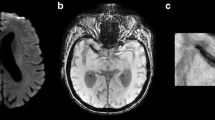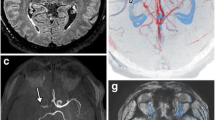Abstract
Objectives
This study evaluated the utility of three-dimensional (3D), black-blood (BB), contrast-enhanced, magnetic resonance imaging (MRI) for the detection of intraluminal thrombi in acute stroke patients.
Methods
Forty-seven patients with acute stroke involving the anterior circulation underwent MRI examination within 6 h of clinical onset. Cerebral angiography was used as the reference standard. In a blinded manner, two neuroradiologists interpreted the following three data sets: (1) diffusion-weighted imaging (DWI) + 3D BB contrast-enhanced MRI; (2) DWI + susceptibility weighted imaging (SWI); (3) DWI + 3D BB contrast-enhanced MRI + SWI.
Results
Of these patients, 47 had clots in the middle cerebral artery and four had clots in the anterior cerebral artery. For both observers, the area under the curve (Az) for data sets 1 and 3, which included 3D BB contrast-enhanced MRI, was significantly greater than it was for data set 2, which did not include 3D BB contrast-enhanced MR imaging (observer 1, 0.988 vs 0.904, p = 0.001; observer 2, 0.988 vs 0.894, p = 0.000).
Conclusions
Three-dimensional BB contrast-enhanced MRI improves detection of intraluminal thrombi compared to conventional MRI methods in patients with acute ischaemic stroke.
Key Points
• BB contrast-enhanced MRI helps clinicians to assess the intraluminal clot
• BB contrast-enhanced MRI improves detection of intraluminal thrombi
• BB contrast-enhanced MRI for clot detection has a higher sensitivity




Similar content being viewed by others
Change history
19 November 2018
The original version of this article, published on 19 March 2018, unfortunately contained a mistake. In the section “MR examination,” the contrast medium Gadoterate meglumine was incorrectly named Gadodiamide.
19 November 2018
The original version of this article, published on 19 March 2018, unfortunately contained a mistake. In the section ���MR examination,��� the contrast medium Gadoterate meglumine was incorrectly named Gadodiamide.
Abbreviations
- ASPECT:
-
Alberta Stroke Program Early CT Score
- BB:
-
Black blood
- iMSDE:
-
Improved motion-sensitised driven-equilibrium
- VISTA:
-
Volumetric isotropic turbo spin-echo acquisition
References
Derex L, Nighoghossian N, Hermier M, Adeleine P, Froment JC, Trouillas P (2002) Early detection of cerebral arterial occlusion on magnetic resonance angiography: predictive value of the baseline NIHSS score and impact on neurological outcome. Cerebrovasc Dis 13:225–229
Albers GW, Thijs VN, Wechsler L et al (2006) Magnetic resonance imaging profiles predict clinical response to early reperfusion: the diffusion and perfusion imaging evaluation for understanding stroke evolution (DEFUSE) study. Ann Neurol 60:508–517
Kidwell CS, Jahan R, Gornbein J et al (2013) A trial of imaging selection and endovascular treatment for ischemic stroke. N Engl J Med 368:914–923
Kidwell CS, Wintermark M, De Silva DA et al (2013) Multiparametric MRI and CT models of infarct core and favorable penumbral imaging patterns in acute ischemic stroke. Stroke 44:73–79
Lansberg MG, Lee J, Christensen S et al (2011) RAPID automated patient selection for reperfusion therapy: a pooled analysis of the Echoplanar Imaging Thrombolytic Evaluation Trial (EPITHET) and the Diffusion and Perfusion Imaging Evaluation for Understanding Stroke Evolution (DEFUSE) Study. Stroke 42:1608–1614
McTaggart RA, Jovin TG, Lansberg MG et al (2015) Alberta stroke program early computed tomographic scoring performance in a series of patients undergoing computed tomography and MRI: reader agreement, modality agreement, and outcome prediction. Stroke 46:407–412
Nezu T, Koga M, Nakagawara J et al (2011) Early ischemic change on CT versus diffusion-weighted imaging for patients with stroke receiving intravenous recombinant tissue-type plasminogen activator therapy: stroke acute management with urgent risk-factor assessment and improvement (SAMURAI) rt-PA registry. Stroke 42:2196–2200
Schellinger PD, Fiebach JB, Jansen O et al (2001) Stroke magnetic resonance imaging within 6 hours after onset of hyperacute cerebral ischemia. Ann Neurol 49:460–469
Schellinger PD, Fiebach JB, Hacke W (2003) Imaging-based decision making in thrombolytic therapy for ischemic stroke: present status. Stroke 34:575–583
Flacke S, Urbach H, Keller E et al (2000) Middle cerebral artery (MCA) susceptibility sign at susceptibility-based perfusion MR imaging: clinical importance and comparison with hyperdense MCA sign at CT. Radiology 215:476–482
Hermier M, Nighoghossian N (2004) Contribution of susceptibility-weighted imaging to acute stroke assessment. Stroke 35:1989–1994
Santhosh K, Kesavadas C, Thomas B, Gupta AK, Thamburaj K, Kapilamoorthy TR (2009) Susceptibility weighted imaging: a new tool in magnetic resonance imaging of stroke. Clin Radiol 64:74–83
Ota H, Yarnykh VL, Ferguson MS et al (2010) Carotid intraplaque hemorrhage imaging at 3.0-T MR imaging: comparison of the diagnostic performance of three T1-weighted sequences. Radiology 254:551–563
Yuan C, Mitsumori LM, Ferguson MS et al (2001) In vivo accuracy of multispectral magnetic resonance imaging for identifying lipid-rich necrotic cores and intraplaque hemorrhage in advanced human carotid plaques. Circulation 104:2051–2056
Yuan C, Hatsukami TS, Obrien KD (2001) High-Resolution magnetic resonance imaging of normal and atherosclerotic human coronary arteries ex vivo: discrimination of plaque tissue components. J Investig Med 49:491–499
Kim YS, Kwak HS, Chung GH, Hwang SB (2015) Manual aspiration thrombectomy using the Penumbra catheter in patients with acute M1 occlusion: a single-center study. Interv Neuroradiol 21:694–699
Fiebach JB, Schellinger PD, Jansen O et al (2002) CT and diffusion-weighted MR imaging in randomized order: diffusion-weighted imaging results in higher accuracy and lower interrater variability in the diagnosis of hyperacute ischemic stroke. Stroke 33:2206–2210
Campbell BC, Christensen S, Levi CR et al (2012) Comparison of computed tomography perfusion and magnetic resonance imaging perfusion-diffusion mismatch in ischemic stroke. Stroke 43:2648–2653
Rovira A, Orellana P, Alvarez-Sabin J et al (2004) Hyperacute ischemic stroke: middle cerebral artery susceptibility sign at echo-planar gradient-echo MR imaging. Radiology 232:466–473
Haacke EM, Xu Y, Cheng YC, Reichenbach JR (2004) Susceptibility weighted imaging (SWI). Magn Reson Med 52:612–618
Park MG, Oh SJ, Baik SK, Jung DS, Park KP (2016) Susceptibility-weighted imaging for detection of thrombus in acute cardioembolic stroke. J Stroke 18:73–79
Qiao Y, Steinman DA, Qin Q et al (2011) Intracranial arterial wall imaging using three-dimensional high isotropic resolution black blood MRI at 3.0 Tesla. J Magn Reson Imaging 34:22–30
Qiao Y, Zeiler SR, Mirbagheri S et al (2014) Intracranial plaque enhancement in patients with cerebrovascular events on high-spatial-resolution MR images. Radiology 271:534–542
Obara M, Van Cauteren M, Honda M, Imai Y, Kuroda K (2014) Assessment of improved motion-sensitized driven equilibrium (iMSDE) for multi-contrast vessel wall screening. Magn Reson Med Sci 13:139–144
Wang J, Yarnykh VL, Yuan C (2010) Enhanced image quality in black-blood MRI using the improved motion-sensitized driven-equilibrium (iMSDE) sequence. J Magn Reson Imaging 31:1256–1263
Obara M, Kuroda K, Wang J et al (2014) Comparison between two types of improved motion-sensitized driven-equilibrium (iMSDE) for intracranial black-blood imaging at 3.0 tesla. J Magn Reson Imaging 40:824–831
Mitomi M, Kimura K, Aoki J, Iguchi Y (2014) Comparison of CT and DWI findings in ischemic stroke patients within 3 hours of onset. J Stroke Cerebrovasc Dis 23:37–42
Kidwell CS, Chalela JA, Saver JL et al (2004) Comparison of MRI and CT for detection of acute intracerebral hemorrhage. JAMA 292:1823–1830
Funding
This study has received funding by Guerbet.
Author information
Authors and Affiliations
Corresponding author
Ethics declarations
Guarantor
The scientific guarantor of this publication is Hyo Sung Kwak.
Conflict of interest
The authors of this manuscript declare no relationships with any companies, whose products or services may be related to the subject matter of the article.
Statistics and biometry
No complex statistical methods were necessary for this paper.
Ethical approval
Institutional Review Board approval was obtained.
Informed consent
Written informed consent was waived by the Institutional Review Board.
Methodology
• prospective
• diagnostic or prognostic study
• performed at one institution
Rights and permissions
About this article
Cite this article
Jang, W., Kwak, H.S., Chung, G.H. et al. Three-dimensional black-blood contrast-enhanced MRI improves detection of intraluminal thrombi in patients with acute ischaemic stroke. Eur Radiol 28, 3840–3847 (2018). https://doi.org/10.1007/s00330-018-5323-4
Received:
Revised:
Accepted:
Published:
Issue Date:
DOI: https://doi.org/10.1007/s00330-018-5323-4




